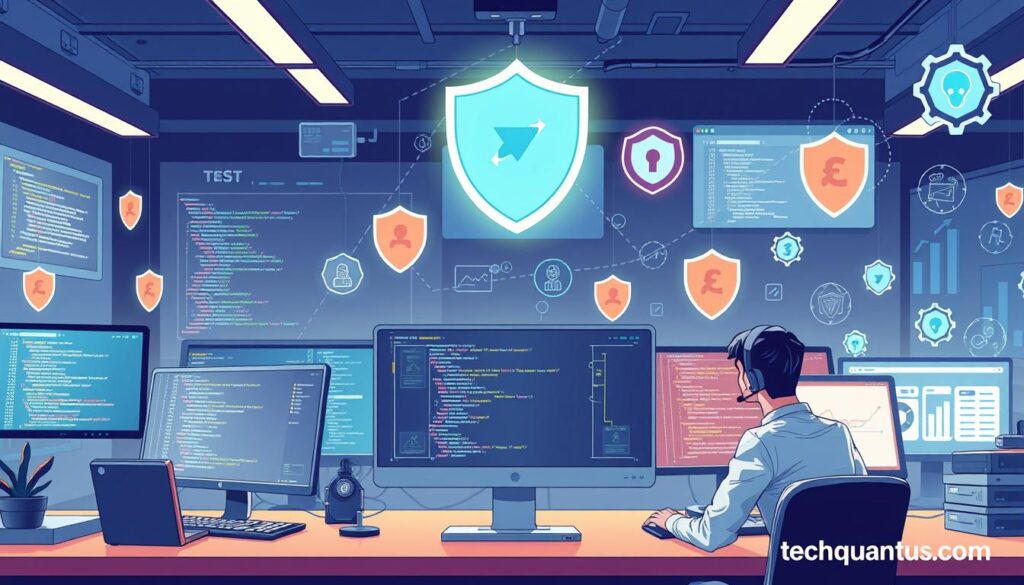Did you know that certified staff can add over $30,000 in value to their organizations each year? This shows how important strong security in software development is. It’s especially true for those working on CISSP domain 8 in their cybersecurity journey. Software development security is key to managing risks in today’s world.
In this guide, you’ll learn how software development security protects applications at every stage. Knowing CISSP domain 8 helps you spot vulnerabilities and apply best practices. It boosts your skills as an information security pro.
Key Takeaways
- CISSP domain 8 focuses on secure practices in software development.
- Knowing about software vulnerabilities is crucial for managing risks in cybersecurity.
- Adding security to the SDLC makes apps more reliable and protects data.
- CISSP certification needs deep knowledge of all security areas, including software development.
- Using best practices can lower security risks and increase company value.
Understanding Software Development Security in CISSP Domain 8
Software development security is key in CISSP domain 8. It shows how important secure coding is to avoid risks. Knowing this domain helps you deal with cybersecurity’s challenges. It gives you the basic ways to keep apps safe.
It’s vital for both development teams and security roles. Knowing about software security makes projects better and keeps the company safe.
Assessing vulnerabilities is a big part of this domain. When developers know about software development security, they make apps that can fight off cyber threats. For example, after the Equifax breach, protecting personal info became even more important.
Also, knowing how different security areas work together opens up career paths in cybersecurity. By understanding how software development, risk management, and security architecture connect, you can find jobs that need both tech skills and security knowledge.
Lastly, having a secure development environment is crucial. This means setting up strong network security to keep threats out. This way, apps work right and keep sensitive data safe from new risks.
The Importance of Secure Software Development
Software is now a big part of our daily lives. This makes secure software development very important. It’s key to keep our data safe and trust in technology.
With cyberattacks on the rise, we need strong security more than ever. This is crucial for keeping our information safe.
Risks Associated with Insecure Software Development
Insecure software can be a big problem. It can be used by hackers to harm us. The risks include:
- Cyberattacks that mess with software applications.
- Data breaches that let hackers get to our private info.
- Reputational damage from security failures, which can lose customer trust.
These risks show why we need to focus on making software secure. It’s about protecting our valuable assets.
Data Protection and Risk Management in Cybersecurity
To fight these risks, we need good data protection plans. Good cybersecurity risk management means:
- Finding weak spots in software.
- Using security measures to keep data safe.
- Watching software for any odd behavior.
- Keeping software up to date to fix new problems.
Knowing these steps helps us keep our data safe. It makes sure our software development is secure.
| Risk Type | Description | Impact |
|---|---|---|
| Cyberattacks | Malicious attempts to exploit software vulnerabilities | Loss of service and potential data compromise |
| Data Breach | Unauthorized access to sensitive information | Legal action, financial penalties, and trust erosion |
| Reputational Damage | Loss of customer confidence due to security incidents | Long-term business impacts and customer attrition |
Key Principles of Software Development Security
It’s key to know the main principles of software security to make apps that last and keep data safe. The CIA (Confidentiality, Integrity, and Availability) rules are at the heart of secure app making. These rules help ensure apps meet user needs and follow security guidelines.
Confidentiality, Integrity, and Availability in Development
Confidentiality, integrity, and availability are vital in software security. Confidentiality means only the right people can see sensitive data. Integrity keeps data accurate and unchanged. Availability makes sure data and resources are there when needed. By following these rules, you build a strong security base.
Secure Software Development Life Cycle (SDLC)
The secure software development life cycle (SDLC) puts security into every step of making software. It covers planning, design, coding, testing, deployment, and upkeep. A secure SDLC means security is always on your mind, not just an add-on. This way, you avoid risks and keep security and business goals in line.
| Principle | Description | Importance in Development |
|---|---|---|
| Confidentiality | Protection of sensitive information from unauthorized access. | Essential for maintaining trust and compliance. |
| Integrity | Ensuring data accuracy and consistency throughout its life cycle. | Vital for reliable operations and decision making. |
| Availability | Ensuring that information and resources are accessible when needed. | Critical for operational efficiency and user satisfaction. |
Types of Software Development Methodologies
It’s key to know the different software development methods for good security. Methods like waterfall, agile, and DevOps affect how software is made and its security.
The waterfall method is straightforward and follows a sequence. It’s best for projects with clear needs. But, security checks might come too late, leaving vulnerabilities undiscovered until almost the end.
The agile method, on the other hand, is all about quick, flexible development. It lets security checks in at every step. This makes agile great for teams that need to adapt fast to security threats.
DevOps combines development and operations, focusing on automation and monitoring. It makes teams work better together and keeps security in every step. With DevOps, updates can be made fast and safely.
Here’s a quick look at how these methods stack up for security:
| Methodology | Strengths | Weaknesses |
|---|---|---|
| Waterfall | Clear phases and documentation | Inflexible, late security testing |
| Agile | Iterative, quick feedback | Less documentation, which may lead to oversight |
| DevOps | Collaborative, integrates security throughout | Requires a cultural shift in teams |
CISSP Domain 8: Security Practices for Application Development
It’s crucial to have security practices in application development to lower risks and protect sensitive data. By sticking to application security best practices, you can greatly cut down the chance of security breaches. This part will cover important practices and common vulnerabilities that developers need to be aware of in CISSP domain 8.
Application Security Best Practices
To make sure your application is secure, follow these best practices:
- Secure Coding Guidelines: Following best coding practices helps avoid coding mistakes that could lead to vulnerabilities.
- User Authentication: Use strong user authentication methods, like multi-factor authentication, to check user identities.
- Regular Security Assessments: Do assessments often to find and fix vulnerabilities before they’re exploited.
- Input Validation: Make sure to validate all user inputs to prevent attacks like SQL injection and cross-site scripting.
- Code Reviews: Do code reviews regularly to catch potential security issues early.
Common Vulnerabilities in Software Development
Knowing common vulnerabilities is key for developers to boost their application security. Some top vulnerabilities include:
- SQL Injection: Attackers can mess with database queries by not validating user input properly.
- Cross-Site Scripting (XSS): This lets attackers inject harmful scripts into web pages users see.
- Insecure API Endpoints: Badly secured APIs can cause unauthorized access and data leaks.
- Broken Authentication: Weak authentication can let attackers take over user accounts.
- Security Misconfiguration: Not setting up server and application settings securely can make systems vulnerable.
Security Controls and Frameworks
In software development, strong security controls and frameworks are key. They protect applications from threats. They also help manage risks and follow cybersecurity rules.
Application Security Controls
Application security controls protect software from start to finish. They use various methods to reduce risks. Here are some important controls:
- Access Controls: Limit user permissions to prevent unauthorized access and data breaches.
- Encryption: Secure data to stop unauthorized access and interception.
- Monitoring: Watch applications for unusual activity and respond quickly to threats.
Using these controls makes software development safer.
Common Security Frameworks for Software Development
Security frameworks guide organizations in using effective security controls. They help in managing software development security. Here are some well-known frameworks:
| Framework | Purpose |
|---|---|
| NIST Cybersecurity Framework | Offers a detailed way to manage and lower cybersecurity risk, with best practices. |
| OWASP Top Ten | Lists the top ten web application security risks and how to fix them. |
| CIS Critical Security Controls | Provides best practices for cyber defense, focusing on key security measures. |
These frameworks standardize security practices. They ensure critical security controls are used well. Using them helps with compliance and builds a security-aware culture.

Managing Third-Party Software Risk
More and more, companies use third-party software. This means they face new risks. It’s key to know the risks from outside vendors to keep data safe. Good vendor risk management can help protect against these dangers.
Vendor Risk Management Strategies
There are several ways to manage risks from vendors. These steps help keep your company safe:
- Due Diligence: Check a vendor’s security before you work with them.
- Contractual Obligations: Make sure contracts have clear security rules.
- Ongoing Monitoring: Keep an eye on vendor security to spot any issues.
- Incident Response Plans: Work together on plans for security breaches.
Assessing Third-Party Security Posture
It’s important to trust your vendors. Here’s how to check their security:
- Security Certifications: Look for certifications that show they care about security.
- Audits and Assessments: Check their security audits to see if they follow best practices.
- Vulnerability Assessments: Find and fix any weaknesses in their systems.
- Transparency: Talk openly about their security and how they handle incidents.
By using these strategies and checking your vendors’ security, you can lower risks. This makes your company safer and more secure.
| Strategy | Description |
|---|---|
| Due Diligence | Evaluate a vendor’s security practices before engagement. |
| Contractual Obligations | Include security requirements in contracts. |
| Ongoing Monitoring | Regularly assess vendor security practices. |
| Incident Response Plans | Develop collaborative plans to manage breaches. |
| Security Certifications | Confirm relevant certifications indicating security measures. |
| Audits and Assessments | Review security audits and compliance status. |
| Vulnerability Assessments | Identify and remediate vulnerabilities in vendor systems. |
| Transparency | Encourage open communication on security practices. |
Development Environment Security
Keeping the development environment safe is key to protecting apps from threats. A secure environment boosts software security and encourages good practices in software making. Knowing how to protect development tools and environments is vital for security in software creation.
Securing Development Tools and Environments
To ensure development environment security, follow these steps:
- Keep all development tools and environments up to date to fix known issues.
- Use role-based access controls to limit who can use sensitive tools and environments.
- Use automated testing tools to find security problems early.
- Make sure version control systems are set up right to stop unauthorized changes.
- Train developers on secure coding to raise their awareness.
These steps can greatly lower risks in securing development tools. Also, adding security to the CI/CD pipeline keeps software development safe.
| Development Tool | Security Measures | Purpose |
|---|---|---|
| Integrated Development Environment (IDE) | Code analysis, plugin security | Aid developers in writing secure code |
| Version Control System | Access controls, encryption | Track code changes securely |
| Automated Testing Tools | Regular updates, vulnerability scanning | Identify vulnerabilities early |
| Containerization Tools | Isolation, resource limits | Run applications in secure environments |
Focus on making the development environment secure is crucial for safe apps. By securing development tools and environments well, companies can lessen attack risks. This promotes a secure culture in software development.
Testing and Assessment in Software Development Security
In software development security, testing and assessment are key. They help find vulnerabilities and make sure applications are safe. Security tests like penetration testing, code reviews, and automated scanning find flaws before they can be used.
Security Testing Techniques
Using good security testing techniques is vital for secure software. Here are some important methods:
- Penetration Testing: It mimics real attacks to find software weaknesses.
- Code Reviews: Developers check source code for security issues.
- Automated Scanning: Tools like Fortify WebInspect and Intruder find known vulnerabilities quickly.
- Dynamic Analysis: It checks software as it runs to find vulnerabilities.
- Static Analysis: It reviews code without running it to find weaknesses early.
| Testing Technique | Description | Benefits |
|---|---|---|
| Penetration Testing | Simulated cyber-attacks by ethical hackers. | Uncovers real-world vulnerabilities and recommends fixes. |
| Code Reviews | Manual review of source code by developers. | Identifies security issues before deployment. |
| Automated Scanning | Tools that automatically assess software vulnerabilities. | Speeds up the testing process and ensures comprehensive coverage. |
Continuous Integration and Continuous Deployment (CI/CD) Security
Adding security to CI/CD is key for modern software. It makes sure security is part of the whole development process. This way, software can be released faster and more securely. CI/CD security includes:
- Automated Testing: Automated security tests in the CI/CD pipeline find issues early.
- Continuous Monitoring: Ongoing assessments during development give real-time security insights.
- Shift-Left Security: Adding security early in development catches vulnerabilities early.

Using CI/CD security practices improves software quality. It ensures vulnerabilities are found and fixed early. With thorough security testing, you can build a solid base for secure software development.
Compliance and Regulatory Considerations
Understanding compliance and regulatory requirements is key in software development security. Organizations must navigate a complex landscape of laws and standards. This is to protect sensitive data and ensure operational integrity. Familiarity with regulations like GDPR, HIPAA, and PCI-DSS is crucial. These regulations help organizations secure their software and keep user trust.
Understanding Regulatory Requirements
Regulatory requirements set the benchmarks for acceptable practices in software development. They aim to protect personal information and ensure organizations take necessary precautions. Each regulation has its specific guidelines, affecting how data is stored, processed, and shared. For example:
- GDPR: Enforces strict rules on data handling, requiring transparency and consent from users.
- HIPAA: Mandates safeguards for personal health information, critical for healthcare software.
- PCI-DSS: Requires security measures for organizations handling payment card data.
Understanding these regulatory requirements is the first step toward creating a robust compliance framework. This framework aligns with your organization’s goals.
Implementing a Compliance Framework
Creating an effective compliance framework involves more than just understanding regulations. It requires implementing systems and processes that ensure adherence to these standards. Key steps include:
- Conducting a risk assessment to identify vulnerabilities.
- Establishing policies and procedures that align with legal requirements.
- Training staff on compliance practices and the importance of data protection.
- Regularly reviewing and updating your compliance framework to adapt to new regulations.
A well-structured compliance framework not only satisfies regulatory requirements. It also strengthens your organization’s security posture. This fosters trust amongst clients and stakeholders.
Emerging Technologies in Software Development Security
The world of software development security is changing fast. New technologies are coming along, and it’s key to use them in your security plans. This part talks about how machine learning and adaptable measures help fight new threats.
Utilizing Machine Learning for Security Enhancements
Machine learning is changing how we keep software safe. It looks for patterns and finds oddities that might be threats. These systems get better with time, thanks to learning from past data.
This is a big help in finding and fixing weaknesses before they become problems. Machine learning also makes some security tasks easier, which saves time and effort. Companies that use these tools see less risk and respond faster to threats.
Adapting to New Threat Vectors
New technologies bring new risks. Things like quantum computing, augmented reality, and the Internet of Things (IoT) are making things harder to protect. It’s important to keep up with these changes to keep your systems safe.
For example, quantum computers could break some encryption methods, so we need to update how we protect data. With more IoT devices around, there are more ways for hackers to get in. By always updating your security, you can face future dangers head-on.
| Technology | Description | Impact on Security |
|---|---|---|
| Machine Learning | Algorithms that improve through experience to identify anomalies. | Enhanced vulnerability detection and automated responses. |
| Quantum Computing | Computing using quantum-mechanical phenomena. | Potential to weaken current cryptographic methods. |
| 5G Technology | Next-generation mobile networks with faster speeds. | Greater connectivity may increase risks for devices. |
| IoT | Network of interconnected devices for data sharing. | Introduction of more attack surfaces requiring new security measures. |
| Blockchain | Decentralized ledger technology for secure transactions. | Inherent security features that reduce fraud and enhance transparency. |
Conclusion
CISSP Domain 8 highlights the need for strong security in software development. The world of cybersecurity is always changing. You must stay alert and keep up with new threats and best practices.
This effort helps reduce risks in software development. Knowing important regulations and compliance frameworks is also key. It boosts your knowledge and makes you a better cybersecurity pro.
Staying updated with new technologies is crucial for success. A proactive approach is at the heart of software development security. By following this guide, you can make your applications and systems more secure.
This ensures they can better withstand breaches and vulnerabilities.
FAQ
What is CISSP Domain 8, and why is it important?
CISSP Domain 8 deals with Software Development Security. It’s key to avoiding risks in software projects. Knowing this domain helps you spot vulnerabilities and follow the best practices in the software development life cycle (SDLC).
How do I integrate security into the software development life cycle (SDLC)?
Security should be part of every SDLC stage. This includes planning, design, development, testing, deployment, and maintenance. Using secure SDLC methods keeps your data safe and secure.
What are common vulnerabilities in software development I should be aware of?
Look out for SQL injection, cross-site scripting (XSS), and insecure API endpoints. Knowing these vulnerabilities is key to securing your applications.
What are the key principles of software development security?
The main principles are confidentiality, integrity, and availability (CIA). These guide secure coding and ensure applications are built with security in mind.
How do different software development methodologies impact security?
Each method has its own strengths and weaknesses. Agile is flexible and can spot security issues quickly. Waterfall is structured but might overlook security until later.
What are some best practices for application security in software development?
Follow secure coding guidelines and use strong user authentication. Regular security assessments and staying updated on vulnerabilities are also important.
How can I manage third-party software risks?
Use vendor risk management strategies and conduct due diligence. Establish clear contracts and monitor vendors regularly to assess their security.
Why is compliance significant in software development security?
Following regulations like GDPR, HIPAA, and PCI-DSS protects sensitive data. It ensures your software meets industry standards and legal requirements.
How can emerging technologies influence software development security?
New technologies like machine learning and artificial intelligence can boost security. They improve threat detection and response. Keeping up with these technologies is crucial.
What testing and assessment techniques should I utilize in software development security?
Use penetration testing, code reviews, and security assessments in CI/CD practices. This ensures ongoing security and early detection of vulnerabilities.
Source Links
1 . CISSP® Preparation Course – Security Academy Online
2 . 20+ IT Certifications with the Highest Pay
3 . 24 Cutting-Edge Artificial Intelligence Applications | AI Applications in 2024
4 . Foundations of Cybersecurity Week two quizzes: History of cybersecurity, The 8 CISSP domains
- Top E-commerce Trends to Watch in 2025
- I Explore AI for Everyone: Understanding Its Everyday Impact
- Best AI Note-Taking Apps for Students in Switzerland
- RAG Apps: The Simple Stack to Accelerate Your Small Business
- 2025 Data Privacy Laws Update: What Small Businesses Need to Know



